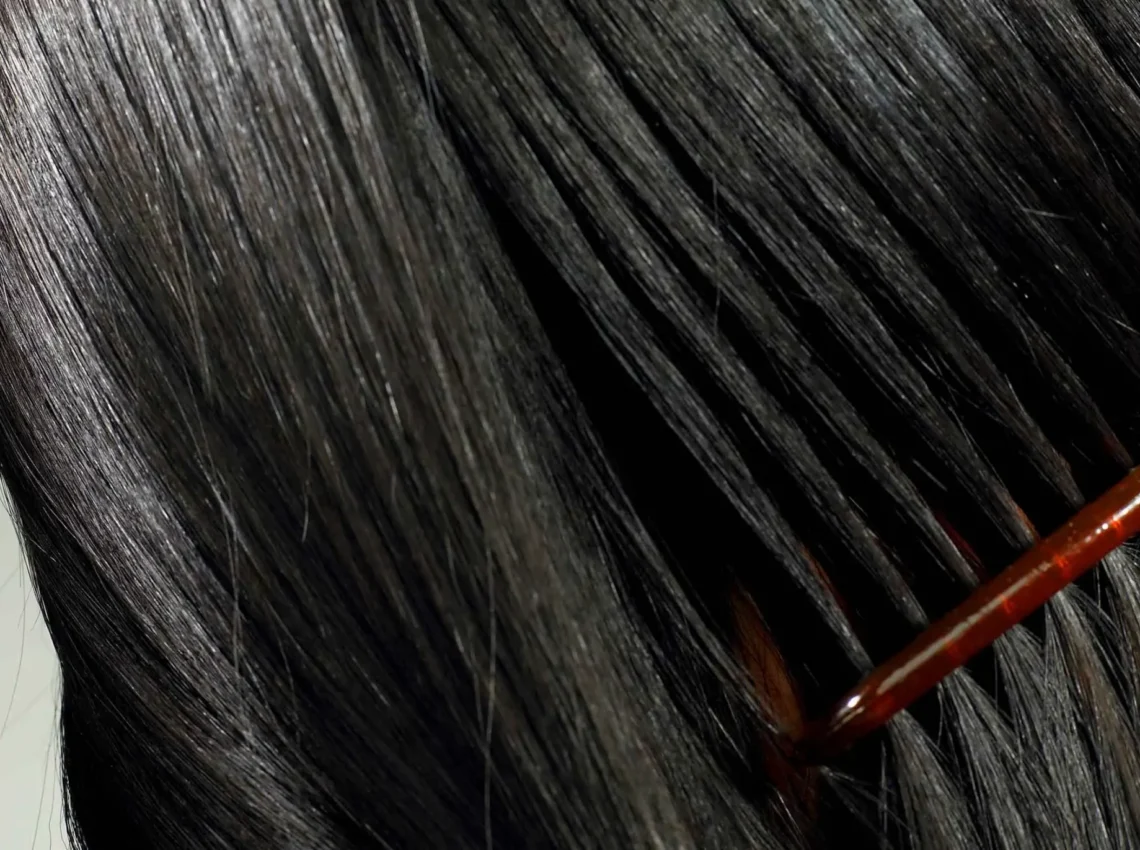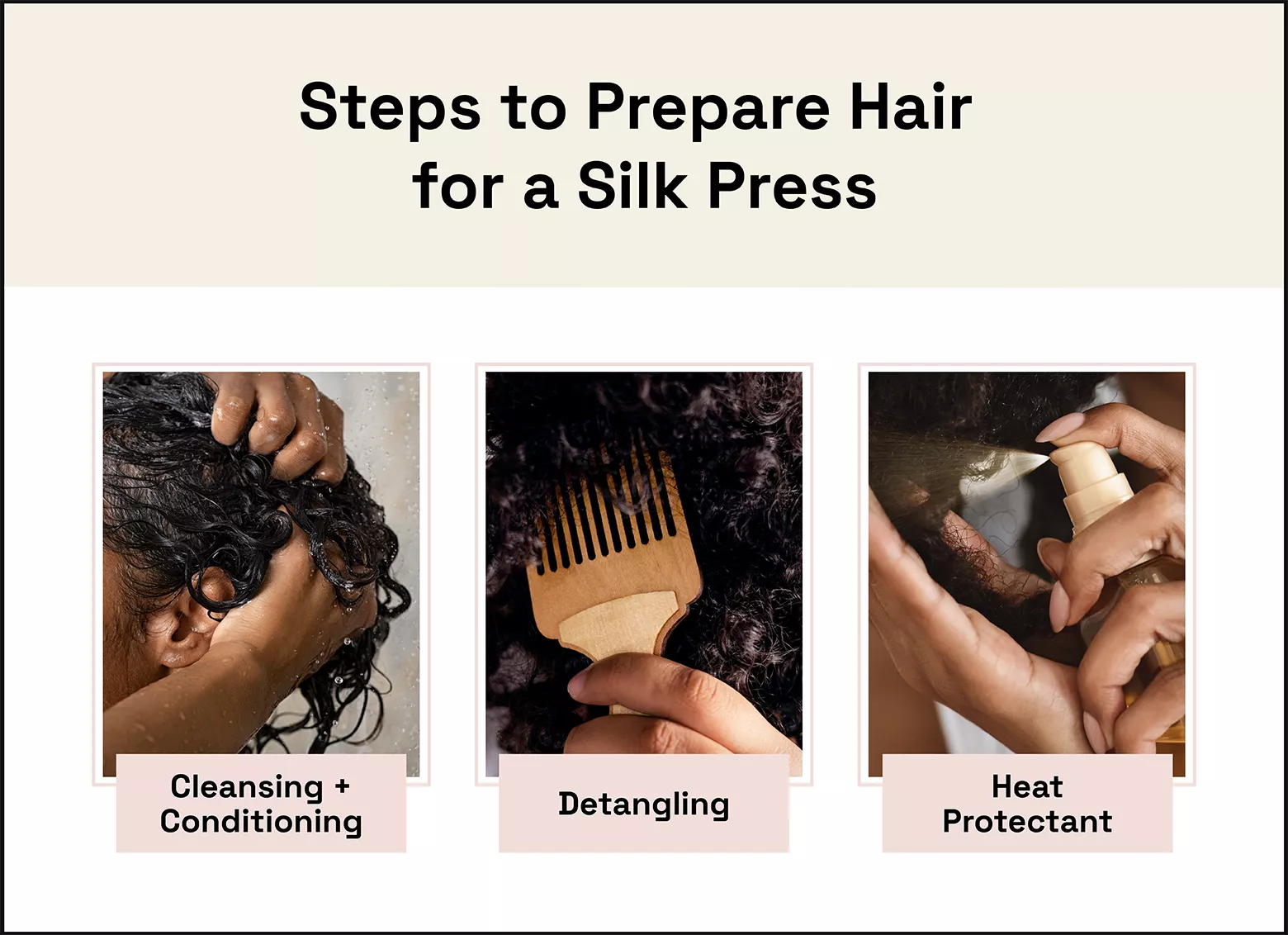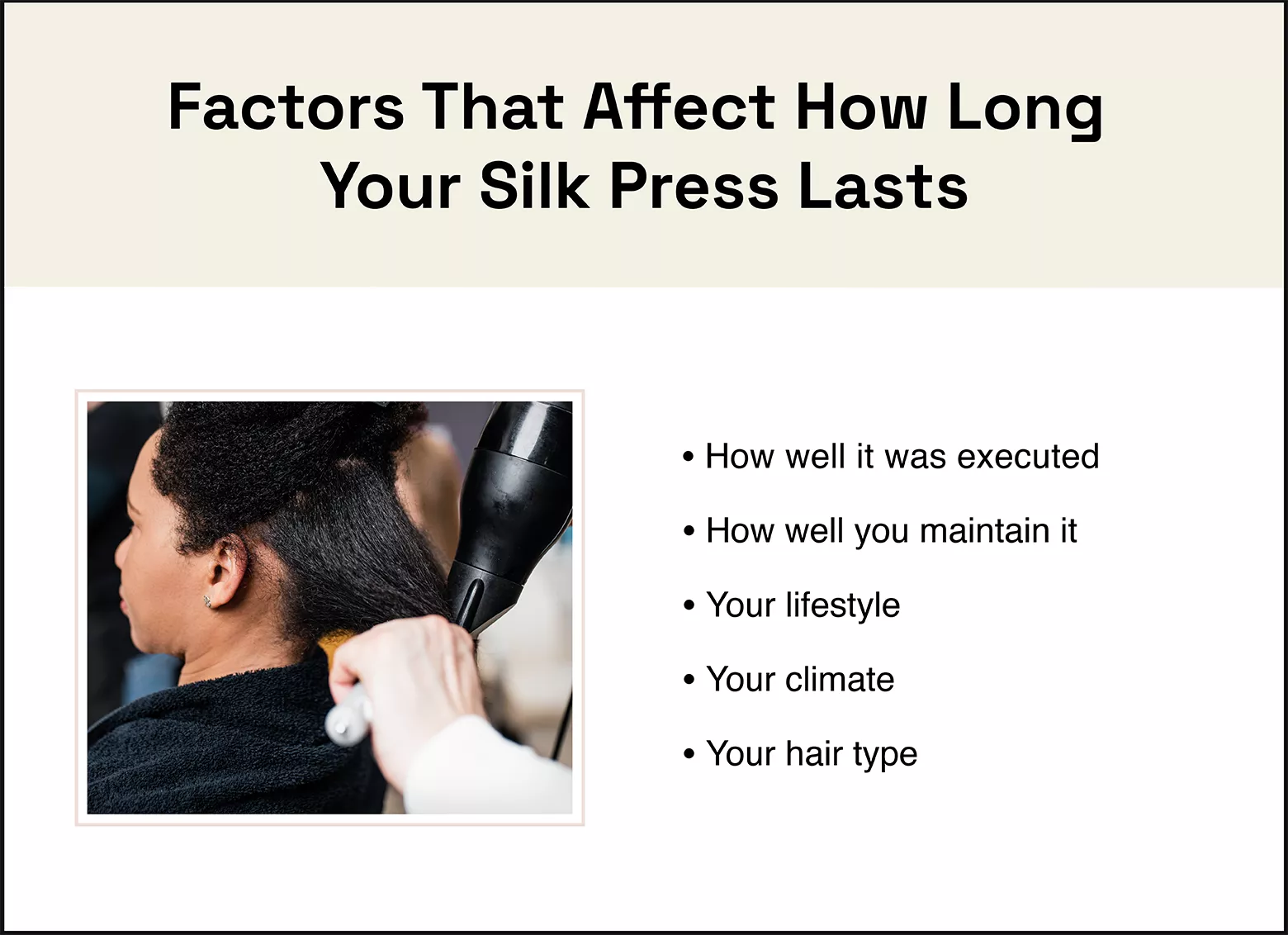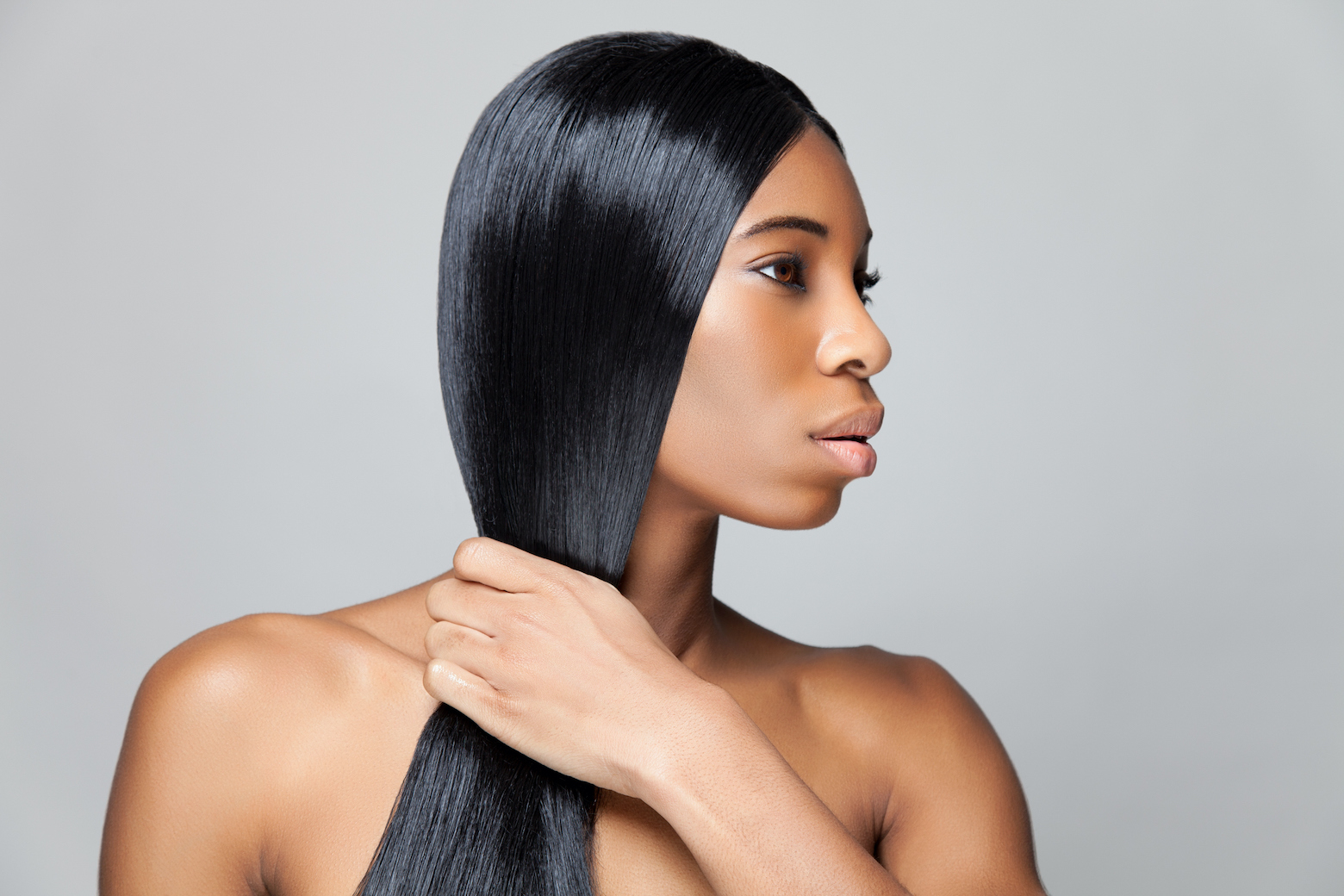What Is a Silk Press? Your Expert Guide

Silk presses are your go-to service if you’re looking for a way to change up your look without the high cost and potential for damage from other straightening services.
Unlike a relaxer or Japanese hair straightening, a silk press doesn’t use chemicals to alter the texture of hair follicles. Instead, hairstylists use heat, styling tools, and products to create a silky, shiny hairstyle. It’s also more affordable compared to other straightening treatment costs.
Silk presses can become your go-to straightening service thanks to these important benefits:
- Low exposure to chemicals
- Affordable compared to other straightening treatments
- Doesn’t alter hair follicles or change curl pattern with proper heat protection
In this guide, we’ll go over the silk press process, how you can maintain the style, and everything else you need to know before walking into your first silk press appointment.
How do you prepare your hair for a silk press?
You can prepare your hair for a silk press by shampooing, conditioning, and detangling before your stylist begins heat styling. Many stylists and silk press experts have their own tricks and techniques for prepping your hair.
Below are a few common tips for prepping, but we recommend going with the products and regimen that works best for your hair.
Cleansing
Starting with a clarifying shampoo can help get rid of buildup, dirt, and other impurities that weigh down your hair. After that, you can double up on your shampoo with a sulfate-free moisturizing shampoo to replenish your hair.
You can also look into pre-poo treatments to give your hair extra protection and nourishment. You’d incorporate pre-poo after the clarifying shampoo and before the moisturizing shampoo.
Conditioning and detangling
Most stylists recommend conditioning your hair before getting a silk press. The best conditioning treatment for your hair depends on your natural hair texture, porosity, and dryness. Depending on the stylist, they may use leave in-conditioners, deep conditioning treatments, or both.
Conditioning helps replenish and lock in moisture before your hair undergoes heat styling. It’s also helpful if you use conditioners in your normal detangling process. Lightweight formulas are best to ensure your hair isn’t heavy or greasy from being overly moisturized.
Shana Marie Stewart, cosmetologist and owner of The Hair Whisperer Beauty Bar in Dallas, TX, suggests incorporating hair products into your routine that “reduce brittleness, restore hair follicles, hydrate the hair, and deposit shine back into the hair.”
Stewart’s go-tos include: Design Essentials Honey Crème Shampoo and the Design Essentials Almond Butter Conditioner.
Heat protectant
Applying a heat protectant before heat styling helps fight frizz and protect your hair from heat damage. You can ask your stylist if they have a heat protectant for natural hair to ensure that your hair is well protected.
Many salons offer this prep process as a part of their silk press package, while others may require you to prep your hair at home. Call ahead if you’re unsure so you can know what to expect on the day of your appointment.

What are the steps to a silk press?
You achieve a silk press by cleansing and conditioning hair, sectioning off and blow-drying hair, pressing hair, then cutting and styling hair. Just like prep, many stylists’ techniques vary from person to person.
Communicate with your stylist if you have concerns about certain tools or products or if you have allergies to common beauty ingredients. This can help you both get on the same page before your appointment.
We’ll summarize the general silk press steps below, but keep in mind that your stylist may take different steps or use other products.
Step 1: Cleanse and condition hair
If it’s part of your package, stylists will do all of the prep for your hair during your appointment. They’ll also towel-dry your hair to ensure it isn’t too wet before blow-drying.
Step 2: Section off and blow-dry hair
Next, your stylist will use clips to part your hair into sections and work through drying each. Hair must be completely dry for the straightening process. Blow-drying can also stretch your hair to potentially cut down on the number of passes needed when pressing hair.
Stylists use different types of brushes and attachments while blow-drying. While every stylist has their preferred hair dryer, the Dyson Supersonic holds up to the hype of cutting drying time in half and controlling heat flow to minimize damage. It also offers a selection of styling attachments that make it physically easier to get the blowout job done on different hair types and textures.
Step 3: Press hair
This is the step that separates a silk press from a regular blowout. Once hair is dried, your stylist will section your hair out again and get to work on pressing your hair. They’ll press one section at a time with as few passes as possible.
Some people may only need one pass on low heat, while others may need two or three at a higher temperature. This depends on your texture and the prep done in the previous two steps. Regardless, your stylist should use the lowest heat setting possible with all heat tools to avoid excessive exposure.
Some stylists like using a hot comb instead of or in addition to a flat iron. Other stylists have preferences on ceramic or titanium flat irons, depending on your hair type.
Once your stylist is done, you’ll be left with silky-smooth hair with lots of body and volume. Your hair shouldn’t be stiff or frizzy.
Step 4: Cut and style hair
The last step is to cut and style hair. Even if you weren’t planning on getting a haircut, now would be the perfect time to consider trimming your split ends. This is also the step where you can get any curls or waves styled in your hair.
What is needed for a silk press
You’ll need tools and products to both protect and style your hair for a silk press. Below is a general list of what you’ll need after you’ve prepped and detangled your hair:
- Heat protectant to shield hair from heat damage
- Heat-resistant comb to comb through hair while doing a pass with your straightening tool
- Hair clips to divide hair into different sections and keep them out of the way
- Blow-dryer with attachments to dry hair before pressing with your straightening tool
- Straightening tool like a flat iron to press hair after blow-drying
- Any oils or styling products to help style and nourish hair before and/or during the blow-drying and straightening process
Some stylists opt for additional or alternative tools or products, like additional serums while heat styling. You can ask local stylists or watch a few silk press videos to see how results from all of these techniques and tools differ.
Can I do a silk press at home?
You can do a silk press at home if you’re knowledgeable about the process and have all the supplies. It can be tough to do if you’ve never had it done before or if you don’t frequently use heat styling tools in your regular routine. Certain tools, like hot combs, are best left in the hands of a stylist.
When in doubt, we recommend going to a local stylist so you can see how the process is done and get some tips for doing it at home.
How long can a silk press take?
A silk press appointment can take anywhere between two to four hours, depending on your hair and the services during your appointment. For example, your appointment may be longer if you’re getting a full cut and style.
Your hair texture may also contribute to how long your appointment will last, especially if your hair takes a long time to dry. You can ask your stylist ahead of time for an estimate if you need to plan around your appointment.
How often should you get a silk press?
You can get a silk press every three to four months, depending on your hair’s health. Although this technique isn’t as damaging as other straightening services, it doesn’t mean you’re completely safe from damage.
Taking precautions can help, but it won’t make much of a difference if you’re frequently exposing your hair to heat with silk presses or other styles. It also takes time and effort to repair heat damage. Instead of taking that risk, wait a few months between silk presses and look into other styles to give your hair a break.
Is a silk press bad for your hair?
A silk press alone isn’t bad for your hair since the damage is mostly dependent on technique and frequency. However, excessive heat exposure can dry out and damage your hair, leading to breakage, split ends, and many other issues. One study also found that heat treatments at high temperatures can modify hair structure and make it more susceptible to humidity.
On the other hand, a silk press can be a part of a healthy hair routine since the process involves cleansing, moisturizing, and trims. It’s also not as damaging as other straightening treatments that use lots of chemicals or more excessive levels of heat.
You can also protect your hair from heat damage by taking the necessary precautions and by ensuring your stylist is using a good technique to minimize exposure. It’s also important to care for your hair afterward to maintain your hair health and integrity.
If your hair is currently damaged or dry, we recommend focusing on your hair’s health first before trying a silk press. This ensures that your hair isn’t vulnerable to further damage during that process.
How long does a silk press last?
A silk press can last between two to five weeks depending on maintenance, how well you or your stylist executed your silk press, your lifestyle, the weather in your area, and your hair. Your silk press may also not last as long after your first time since your hair isn’t used to it yet.
Here are ways to help your silk press last longer:
- Follow all of the silk press best practices for the best results, like starting with healthy and moisturized hair
- Avoid areas and activities that introduce high humidity or moisture, like swimming, saunas, and exercising
- Cover your hair completely in the shower with a shower cap
- Wrap hair at night under a silk or satin bonnet to retain its moisture, style, and prevent breakage
- Sleep on a silk or satin pillowcase for further protection at night
- Minimize heat styling to avoid any more moisture loss or damage
- Use dry shampoo for natural hair to keep hair clean and prolong your wash day a little more
- Look into styles that embrace your curls coming back, like loose buns at night to create waves or curls
Caprice Jones of Salon Divas in Seattle, WA, suggests waiting one to two weeks after getting a silk press to do minimal touch-ups with a flat iron, if necessary.
“Avoid using anything that would weigh down hair or clog pores,” says Jones. Paul Mitchell Super Skinny Serum is also good for taming flyaways. If you wear hair extensions or a weave, SheaMoisture Wig & Weave Tea Tree & Borage Seed Oil Bond Release Spray is a lightweight, non-alcohol product that adds a “lustrous shine” without weighing down your locks.
You can also look into using a hair polish or serum every two to three days. Silk press expert and StyleSeat Brand Ambassador John George recommends using just a few drops to reduce friction and split ends.
However, silk presses aren’t meant to last forever. Occasional touch-ups and products may be safe depending on your hair, but you’ll need to eventually shampoo your hair and welcome back your natural texture.

What happens when you get your hair wet?
Getting your hair wet is an absolute no-no, or you will revert strands back to their natural state, says George. Using shower caps when showering and avoiding humidity can help your silk press last as long as possible.
How do you sleep with this style?
You can either pin curl or wrap your hair, then cover it with a silk or satin scarf. Prepping your hair in either of these styles can help your hair maintain its body and bounce.
Why is my silk press frizzy and puffy?
Your silk press may turn out frizzy or puffy during your appointment if it’s dry or damaged. This is one of the reasons why it’s important to both start with healthy hair and moisturize it prior to heat styling. Both steps can help you lock in moisture before achieving that iconic sleek look.
Silk-pressed hair may also start to look frizzy or puffy once it starts reverting back to its natural state. Maintenance is key to prolonging your look as much as possible.
What tools should I keep at home to help maintain this style?
All of our StyleSeat Pros mention a silk scarf or bonnet and pillowcase as must-haves, as well as basic styling tools like a paddle brush. “The paddle brush helps with scalp stimulation and blood flow — both of which are necessary foundations for healthy hair,” says George. “[It] helps to distribute natural scalp oils throughout the hair, which can cut down on friction and split ends.”
If you have shorter hair, Bennett tells clients to use flexible curling rods or a comb and hair pins to curl strands into place and add a bit of volume.
How much does a silk press cost?
A silk press can cost between $60 and $100 depending on factors like the salon’s location, your stylist’s experience, and services included in your appointment. Ask your stylist ahead of time if you have questions about what’s included with your appointment and if you’re interested in any packages.
How does a silk press compare to other hair straightening treatments?
Silk presses typically use the least amount of chemicals and heat compared to other straightening treatments. As a result, it also lasts the shortest amount of time since this technique isn’t harsh on your hair or breaks down any of its bonds.
Here are a few common straightening treatments:
- Flat ironing is a part of the silk press process and only involves straightening hair with a flat iron.
- Blowouts are normally done with just a blow-dryer, while a silk press uses both a straightening tool and a blow-dryer.
- Keratin treatments are a type of blowout that involves applying and sealing the keratin formula in the hair before finishing off with the blow-dryer.
- Silk wraps are a technique that involves wrapping hair in plastic wrap and blow-drying it for a similar straight result as a silk press.
- Press and curls are a classic ’90s technique that uses a hot comb to press hair, then uses oil or grease to curl or style the hair. This results in a stiffer look compared to the smooth and sleek results of a silk press.
- Relaxers are strong products that chemically straighten hair permanently.
George notes that frizzy hair is not exclusive to curly hair or Black hair. “All hair types can benefit from a good straightening. But a silk press benefits the curliest of hair types,” he explains. “The ability to have your Afro-textured hair silky straight without a chemical and without people knowing that your hair is naturally very curly is what separates a silk press from just straightening of the hair.”
Other frequently asked questions
Have a question we haven’t answered? We rounded up a few more common silk press questions below.
Can I get this style with 4C hair?
Silk presses work on 4C and all other thick and curly hair types. If you’re concerned about whether your stylist can work with your hair texture, ask if they’ve had experience with doing a silk press on 4C hair. Any photos from their portfolio or even recommendations from loved ones with similar hair types can help you get a better idea of their experience.
Can I get braids after a silk press?
You shouldn’t get braids right after you’ve shampooed out your silk press since you want to give your hair a break from manipulation and tight styles. Instead, you can use the first couple of weeks after you shampoo out your silk press to focus on cleansing and conditioning your hair and scalp.
Cleansing can clean your hair of the products used to create and maintain your silk press. Conditioning can help restore moisture lost from heat styling.
Can you get a silk press on relaxed hair?
If you have relaxed hair, you can flat iron your hair to make it closer to a “silk pressed” look. However, you should be mindful of the amount of heat, product, and chemicals used since you’ve already used chemicals to relax and straighten your hair. You likely won’t need to do as many passes with a flat iron or use as much heat on relaxed hair compared to natural hair.
Ask your stylist for a consultation ahead of time to see if you’re a good candidate or if they have another solution for the look you want.

Is a silk press worth it?
Silk presses are worth it if you want silky-smooth hair without using a ton of chemicals. It’s also a great choice if you’re looking for a short-term style to mix up your look that won’t put your hair or curl pattern at risk.
If you want longer-lasting straight hair, you can look into other options. Long-term straightening services, like relaxers or keratin treatments, use chemicals for a longer-lasting look. Weaves and wigs are other alternatives that can help you achieve a straightened look without exposing your natural hair to heat or chemicals.
Should I go to the salon for this style?
Going to the salon gets your hair in the hands of a professional and lessens your chances of damage. Many stylists have experience with this process and with many hair types. They also have the expertise to advise you on whether or not you’re a good candidate for a silk press.
Check out their profiles, read the reviews, and pore over the pictures (before-and-after photos are even better) to see if a stylist is a fit for you. Jones advises booking a consultation if you have questions about their services.
“Ask any questions you may have pertaining to your hair and concerns,” says Stewart. “If your stylist can answer all questions without hesitation, this is how you will know you’ve found your new hairstylist.”
Check out our local directory to find a stylist near you who specializes in silk presses.


